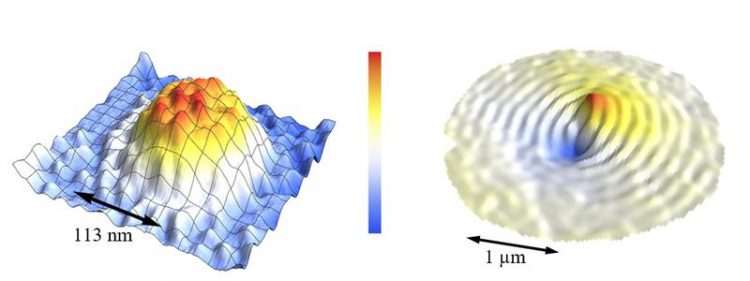Nanomagnetism in X-ray Light

Left: X-ray microscope image of a magnetic skyrmion. Right: Snapshot of the spin waves generated by a magnetic plate excited by microwaves (red: magnetization fully directed upward, blue: downward) © MPI-IS Stuttgart
The MAXYMUS scanning X-ray microscope has its home at Berlin’s synchrotron radiation source BESSY II at Helmholtz Zentrum Berlin. Scientific support is provided by Dr. Markus Weigand from the “Modern Magnetic Systems” department at the Max Planck Institute for Intelligent Systems (MPI-IS) under the management of Professor Dr. Gisela Schütz.
MAXYMUS stands for “MAgnetic X-raY Micro and UHV Spectroscope”. The special fea-tures of this scanning X-ray microscope are its variable specimen environment and broad application spectrum. “It makes it possible to observe ultra-fast processes at 20 times better resolution compared to an optical microscope,” explains Professor Dr. Gisela Schütz.
“In addition to this combination of spatial and temporal resolution, the extremely high sensitivity to the magnetism of nanostructures is unique.” In the field of studying the magnetization dynamics of nanostructures, the department holds the world record in this combination of time (10 picoseconds, i.e. 100 billion images per econd) and spatial resolution (15 nanometers = 0.000,015 mm).
“With MAXYMUS, our users are provided extremely attractive experimentation options, and not only in the area of magnetism,” says Dr. Markus Weigand, who as Max Planck Group Leader in Berlin is responsible for the management and continuous further development of the X-ray microscope.
Researchers in other fields, who for example want to investigate the composition of harmful substance particles in the atmosphere or the photochemistry of endoscopic lithium battery particles, find answers to burning questions here as well. External users can also access the services of MAXYMUS by application. This has led to long standing cooperation with numerous scientists from various research institutions, and the demand for booking MAXYMUS “beamtime” is continuously growing.
In the field of nanomagnetism in particular, exciting new phenomena and technology concepts that can only be “illuminated” with the required speed and spatial resolution in MAXYMUS have recently been causing a stir. Successful cooperation between Max Planck researchers and external scientists, for example at the Helmholtz-Zentrum Dresden-Rossendorf (HZDR), University of Mainz, the Paul-Scherrer Institute in Villingen, Switzerland and the CNRS in Paris led to several high-ranking publications in the renowned journals Nature Physics, Nature Materials, and Nature Nanotechnology in 2016.
They contain fundamental studies in the field known as magnonics. Ultra-fast short-wavelength spin waves (in the magnons particle structure) are intended to enable energy-saving data processing that can be controlled with today’s sophisticated microwave technology. “Making these spin waves visible, comparable to waves made by a stone that drops into water, is very impressive even for a scientist,” explains Dr. Sebastian Wintz of PSI in Villigen, Switzerland (see figure).
Observing the emergence and manipulation of what are known as skyrmions, magnetic vortexes that behave like particles of finite mass and can be controlled with minimal currents, is just as spectacular (see figure). Here too the relevance for future applications in the field of information technology is hotly discussed in countless contributions at corresponding international conferences. Kai Litzius, postgraduate at the chair of Prof. Kläui in Mainz, explains: “By being able to observe the movement of the smallest individual skyrmions, we gain important knowledge about their fundamental magnetic interactions.”
The accuracy of MAXYMUS can be improved by magnitudes with the planned reduction of the length of X-ray light pulses to be realized by BESSY II in the coming years and the significantly greater spatial resolution by using the scattering of X-rays. “Fundamentally, today’s attractive possibilities still harbor the potential for significant optimization. We are still far from reaching the physical limits,” Dr. Markus Weigand predicts.
Publications:
S. Wintz, V. Tiberkevich, M. Weigand, J. Raabe, J. Lindner, A. Erbe, A. Slavin, J. Fass-bender, “Magnetic vortex cores as tunable spin-wave emitters”,
Nature Nanotechnology, 2016, (DOI: 10.1038/nnano.2016.117)
Kai Litzius, Ivan Lemesh, Benjamin Krüger, Pedram Bassirian, Lucas Caretta, Kornel Richter Felix Büttner, Koji Sato, Oleg A. Tretiakov, Johannes Förster, Robert M. Reeve, Markus Weigand, Iuliia Bykova, Hermann Stoll, Gisela Schütz, Geoffrey S.D. Beach and Mathias Kläui, “Skyrmion Hall effect revealed by direct time-resolved X-ray microscopy”, Nature Physics, 2017 (DOI: 10.1038/nphys4000)
Seonghoon Woo, Kai Litzius, Benjamin Krüger, Mi-Young Im, Lucas Caretta, Kornel Rich-ter, Maxwell Mann, Andrea Krone, Robert M. Reeve, Markus Weigand, Parnica Agrawal, Ivan Lemesh, Mohamad-Assaad Mawass, Peter Fischer, Mathias Kläui and Geoffrey S.D. Beach, “Observation of room-temperature magnetic skyrmions and their current-driven dynamics in ultrathin metallic ferromagnets”
Nature Materials, 2016 (DOI: 10.1038/nmat4593)
C. Moreau-Luchaire, C.Moutafis, N. Reyren, J.Sampaio, C.A.F. Vaz, N.Van Horne, K. Bouzehouane, K.Garcia, C. Deranlot, P. Warnicke, P. Wohlhüter, J.-M. George, M. Weigand, J.Raabe, V.Cros and A.Fert, “Additive interfacial chiral interaction in multi-layers for stabilization of small individual skyrmions at room temperature”
Nature Nanotechnology, 2016 (DOI: 10.1038/nnano.2015.313)
Media Contact
More Information:
http://www.is.mpg.deAll latest news from the category: Physics and Astronomy
This area deals with the fundamental laws and building blocks of nature and how they interact, the properties and the behavior of matter, and research into space and time and their structures.
innovations-report provides in-depth reports and articles on subjects such as astrophysics, laser technologies, nuclear, quantum, particle and solid-state physics, nanotechnologies, planetary research and findings (Mars, Venus) and developments related to the Hubble Telescope.
Newest articles

NASA: Mystery of life’s handedness deepens
The mystery of why life uses molecules with specific orientations has deepened with a NASA-funded discovery that RNA — a key molecule thought to have potentially held the instructions for…

What are the effects of historic lithium mining on water quality?
Study reveals low levels of common contaminants but high levels of other elements in waters associated with an abandoned lithium mine. Lithium ore and mining waste from a historic lithium…

Quantum-inspired design boosts efficiency of heat-to-electricity conversion
Rice engineers take unconventional route to improving thermophotovoltaic systems. Researchers at Rice University have found a new way to improve a key element of thermophotovoltaic (TPV) systems, which convert heat…



